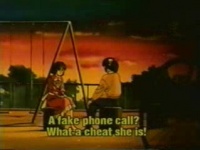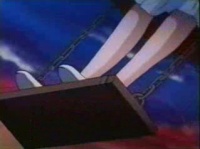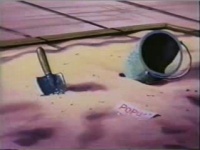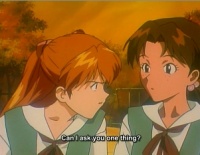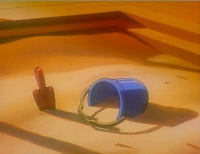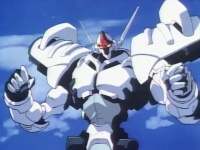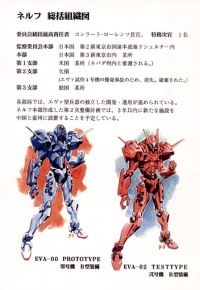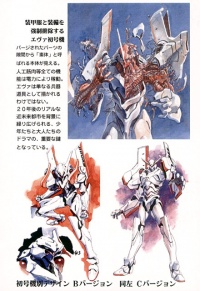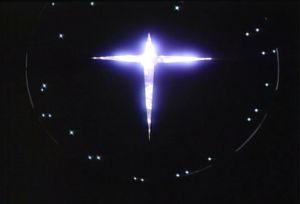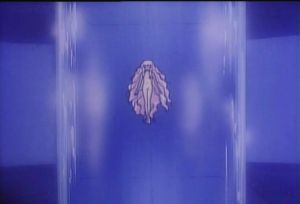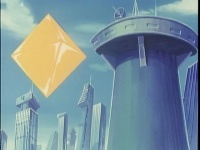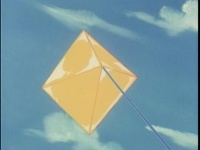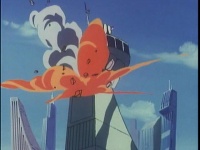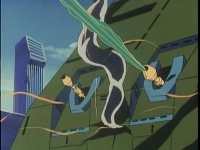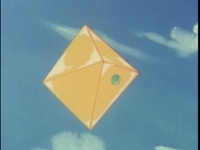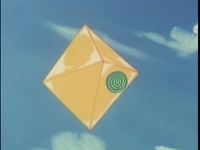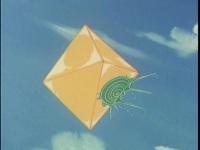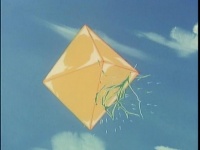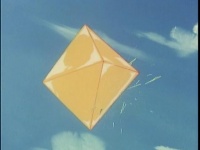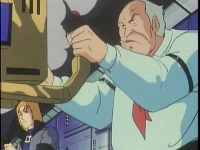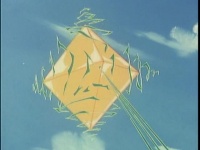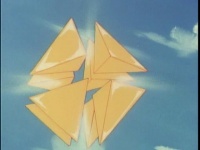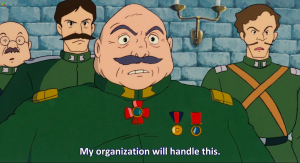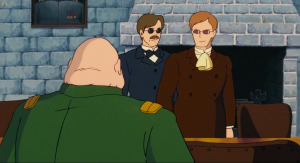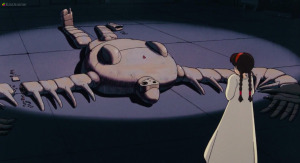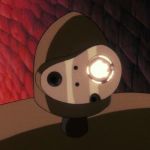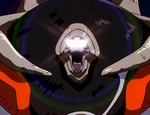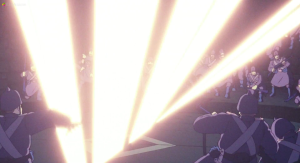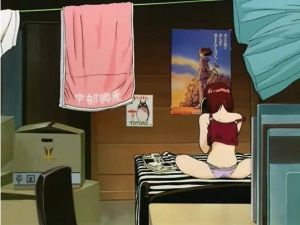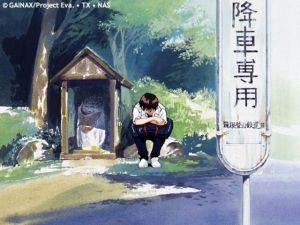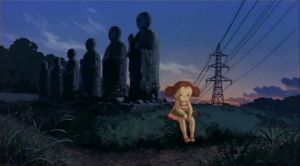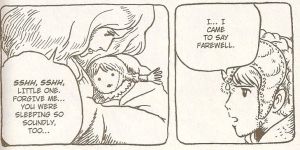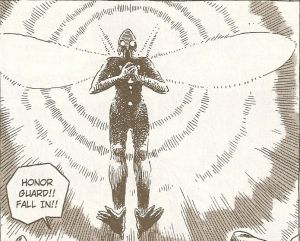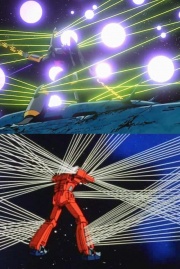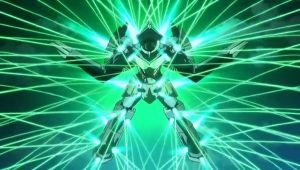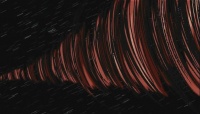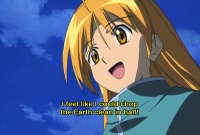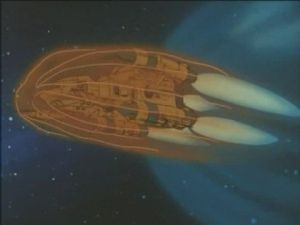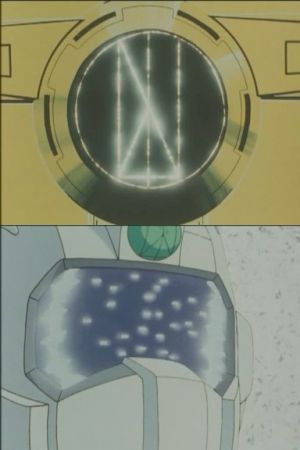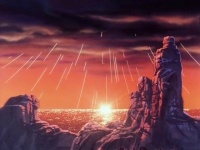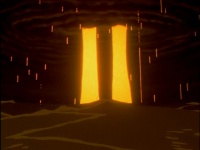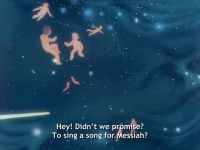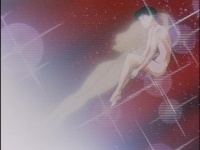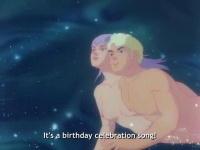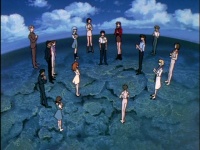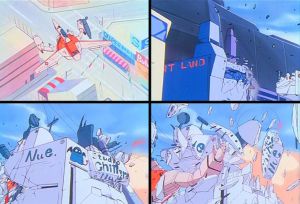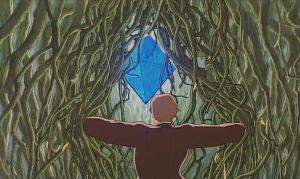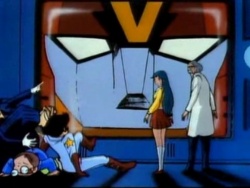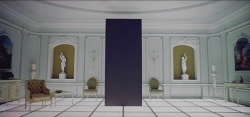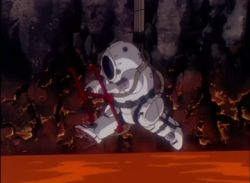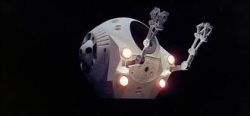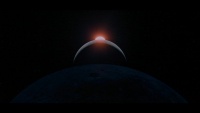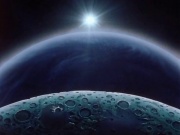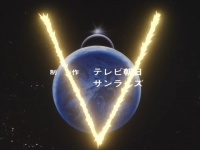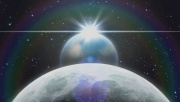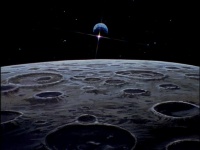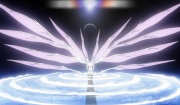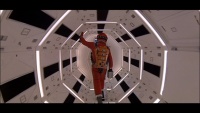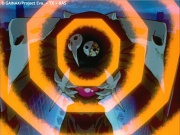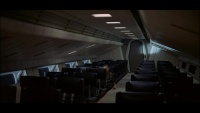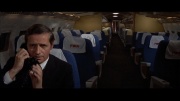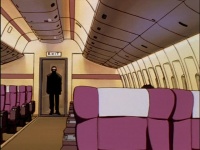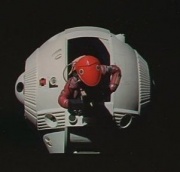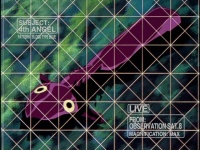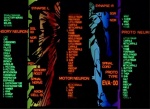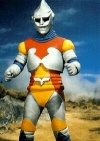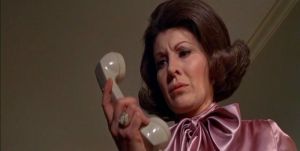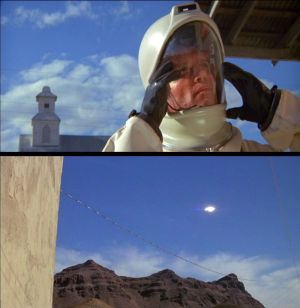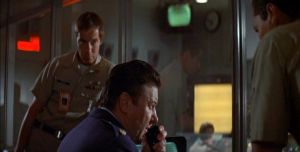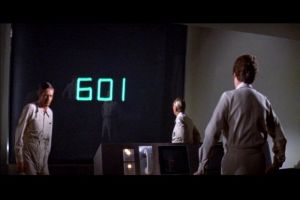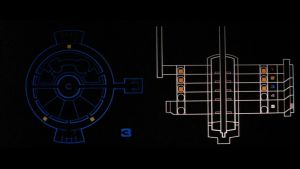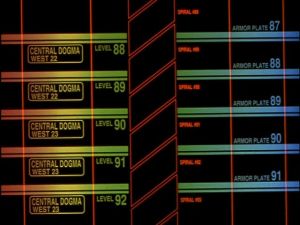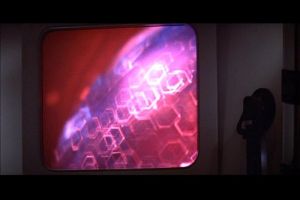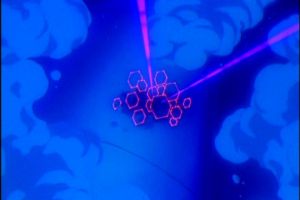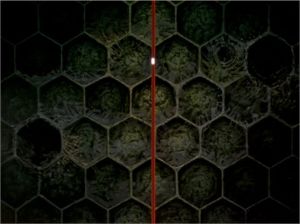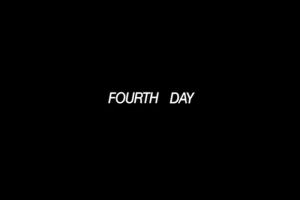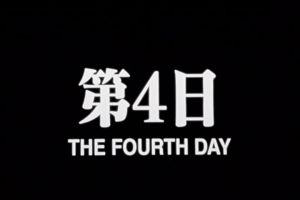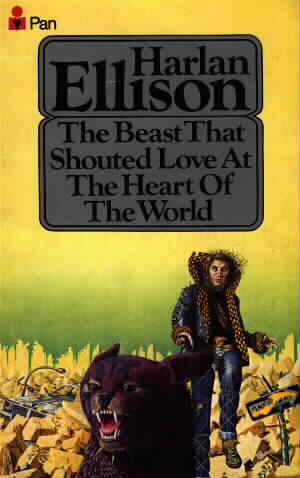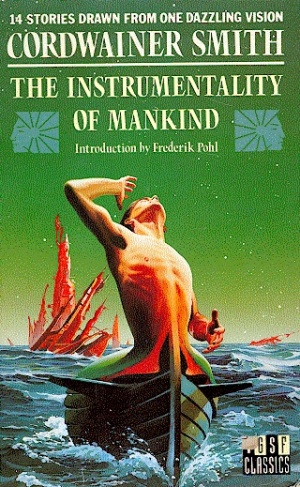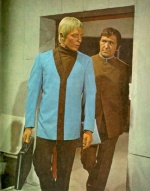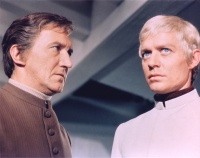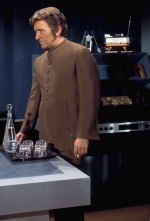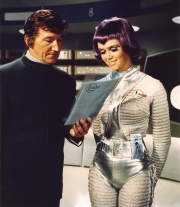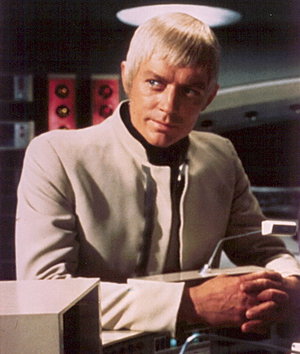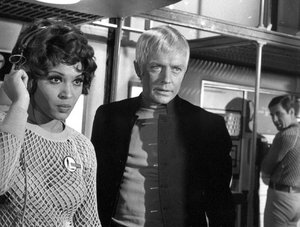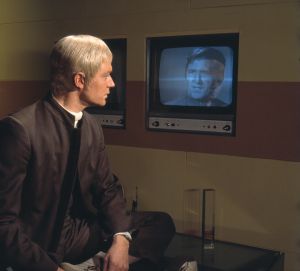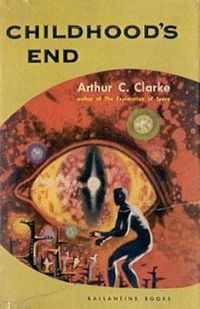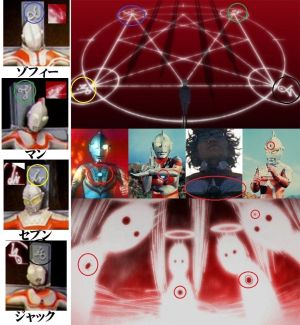Difference between revisions of "Tributes to Other Fiction in Neon Genesis Evangelion"
(→Other Media: added Ultraman Ace, wonder why nobody added this one?) |
UrsusArctos (talk | contribs) |
||
| (13 intermediate revisions by 5 users not shown) | |||
| Line 38: | Line 38: | ||
''Detonator Orgun'' is a three-episode OAV from 1991. While it's impossible to tell for certain whether or not it actually influenced the creators of Evangelion, there are a number of similarities that are worth noticing, even if they are entirely coincidental: | ''Detonator Orgun'' is a three-episode OAV from 1991. While it's impossible to tell for certain whether or not it actually influenced the creators of Evangelion, there are a number of similarities that are worth noticing, even if they are entirely coincidental: | ||
| − | The main character Tomoru synchronizes with a sentient alien bio-mecha; however, it is later revealed that the "aliens" are, in fact, not aliens at all, but super-evolved humans (a plot point possibly influenced by [[Tributes to Other Shows in Neon Genesis Evangelion#The Super Dimension Fortress Macross (超時空要塞マクロス)|the original Macross]]). The final episode features shamelessly overblown biblical symbolism, most notably in the form of Orgun's Grand Cruciform final attack. Smaller visual details include a naked girl floating in a tube, and a couple of [[Gendo Pose|Gendo Poses]]. | + | The main character Tomoru synchronizes with a sentient alien bio-mecha; however, it is later revealed that the "aliens" are, in fact, not aliens at all, but super-evolved humans (a plot point possibly influenced by [[Tributes to Other Shows in Neon Genesis Evangelion#The Super Dimension Fortress Macross (超時空要塞マクロス)|the original Macross]]). The final episode features shamelessly overblown biblical symbolism, most notably in the form of Orgun's Grand Cruciform final attack. Early Evangelion designs bear a strong resemblance to Orgun - although it must be noted that similar design features(such as huge shoulders and horn-like protrusions) were present in other late 80s/early 90s mecha anime. Smaller visual details include a naked girl floating in a tube, and a couple of [[Gendo Pose|Gendo Poses]]. |
| − | [[Image:Detonator orgun grand cruciform.jpg|thumb|left|A cross-shaped flash when Orgun fires the Grand Cruciform]] | + | {{MontageBox |
| − | [[Image:Detonator orgun mhiku tube.jpg|thumb|none|A pale, naked esper girl in a tube]] | + | |float = left |
| + | |columns = 3 | ||
| + | |title = Detonator Orgun vs Evangelion | ||
| + | |colour = | ||
| + | |image1 = [[Image:Orgun.jpg|thumb|200px|Orgun pretending to be a hero.]] | ||
| + | |image2 = [[Image:Proposal_15_nerv-layout.jpg|thumb|200px|Preliminary designs of Eva-00 and Eva-02]] | ||
| + | |image3 = [[Image:Proposal_32_eva01-alt.jpg|thumb|200px|Alternate early Eva-01 designs]] | ||
| + | |image4 = [[Image:Detonator orgun grand cruciform.jpg|thumb|left|A cross-shaped flash when Orgun fires the Grand Cruciform]] | ||
| + | |image5 = [[Image:Detonator orgun mhiku tube.jpg|thumb|none|A pale, naked esper girl in a tube]] | ||
| + | |caption = | ||
| + | }} | ||
| + | {{-}} | ||
{{-}} | {{-}} | ||
| Line 76: | Line 87: | ||
}} | }} | ||
{{-}} | {{-}} | ||
| + | |||
| + | |||
| + | ==Laputa: Castle in the Sky (天空の城ラピュタ)== | ||
| + | "Laputa: Castle in the Sky" is a 1986 animated film written and directed by Hayao Mizayaki. Laputa's primary antagonist, Muska, bears a striking resemblance to Gendo in his mannerisms, his actions, and his tinted, rounded sunglasses. When at fortress Tedis, Muska takes over command from a blustering military general in a scene which mirrors one in Eva's first episode, when Gendo takes over command from a trio of generals who failed to destroy Sachiel. Muska also reveals a Robot ("a mechanical soldier with vast destructive power") to Laputa's protagonist, Sheeta, in a scene which at once mirror's Shinji's first meeting with an Eva Unit 01 in the cage and Misato's first sight of Lilith in Terminal Dogma. The Robot itself bears some resemblance to Lilith with its splayed and damaged limbs. In the subsequent fight against this Robot, the military has little-to-no ability to damage it until they use a powerful bomb, reflecting the inability of the JSSDF in Evangelion to harm Sachiel until they used an N2 Mine. Additionally, the Robot's primary attack is a powerful beam which it shoots from its eyes in a similar manner to Zeruel. While some of these characteristics are wide-ranging tropes, their combined presence in a single sequence and that fact that that sequence is in a Miyazaki film lend credence to the idea that "Laputa" had a direct influence on Anno in the making of Evangelion (for a lengthier discussion of the influence of Miyazaki on Anno, see "Anno & Nausicaa" in the "Nausicaa of the Valley of the Wind" section). | ||
| + | |||
| + | {{MontageBox | ||
| + | |float = left | ||
| + | |columns = 3 | ||
| + | |title = Laputa: Castle in the Sky | ||
| + | |image1 = [[Image:Laputa_General_Muoro_Losing_Command.png|thumb|300px|The blustering General Muoro.]] | ||
| + | |image2 = [[Image:Laputa_Muska_Taking_Command.png|thumb|300px|Proto-Gendo?]] | ||
| + | |image3 = [[Image:Laputa_Sheeta_Robot.png|thumb|300px|Sheeta seeing the Robot for the first time.]] | ||
| + | |image4 = [[Image:Laputa_Robot_Eye_Attack_1.png|thumb|center|150px|The Robot prepares its attack.]] | ||
| + | |image5 = [[Image:19_C129b.jpg|thumb|center|300px|A similar shot of Zeruel.]] | ||
| + | |image6 = [[Image:Laputa_Robot_Eye_Attack_2.png|thumb|300px|The attack itself.]] | ||
| + | |caption = | ||
| + | }} | ||
| + | {{-}} | ||
| + | |||
==My Neighbor Totoro (となりのトトロ)== | ==My Neighbor Totoro (となりのトトロ)== | ||
| Line 223: | Line 253: | ||
[[Image:2001 Octahedrons.jpg|thumb|none|Dave Bowman, tripping balls]] | [[Image:2001 Octahedrons.jpg|thumb|none|Dave Bowman, tripping balls]] | ||
| + | |||
| + | ==Cho Denji Robo Combattler V(超電磁ロボ コンバトラーV)== | ||
| + | |||
| + | A 54 episode TV series directed by Tadao Nagahama, and in a talk between Rahxephon's Yutaka Izubuchi and Hideaki Anno<ref>[http://forum.evageeks.org/post/492098/Anno-interview-about-RahXephon/#492098 Anno interview about Rahxephon]</ref>, they say that the [[FGC:Episode_01_Scene_06|introduction to Evangelion Unit-01 in Episode 1]] was taken from one of the scenes from the beginning of Combattler V. Where all the pilots have been gathered (while the big bad guy is outside laying waste to the city), put into a dark room, then the lights come on revealing the big robot at face level. | ||
| + | |||
| + | [[Image:Combattler v ep1.jpg|thumb|250px|left|The reveal of Combattler to the rest of the pilots]] | ||
{{-}} | {{-}} | ||
| Line 231: | Line 267: | ||
==2001: A Space Odyssey== | ==2001: A Space Odyssey== | ||
| + | |||
| + | *'''The Monoliths''' | ||
Perhaps the most well-known science fiction tribute in the series, Seele's black monoliths are taken from Stanley Kubrick's classic 1968 film, ''2001: A Space Odyssey''. | Perhaps the most well-known science fiction tribute in the series, Seele's black monoliths are taken from Stanley Kubrick's classic 1968 film, ''2001: A Space Odyssey''. | ||
[[Image:2001 monolith1.jpg|thumb|250px|left|Transcendental interior design]] | [[Image:2001 monolith1.jpg|thumb|250px|left|Transcendental interior design]] | ||
| − | |||
In the 2001 novels, the monoliths were actually built by a race of beings who had transferred their consciousnesses to machines, and who later went further and transferred their consciousnesses to non-corporeal form. | In the 2001 novels, the monoliths were actually built by a race of beings who had transferred their consciousnesses to machines, and who later went further and transferred their consciousnesses to non-corporeal form. | ||
Beyond this one notable reference things get highly speculative. The following visual details have been postulated to be 2001 homages by some fans, and they are included here for completeness' sake. (See also the blue octahedron motif above.) | Beyond this one notable reference things get highly speculative. The following visual details have been postulated to be 2001 homages by some fans, and they are included here for completeness' sake. (See also the blue octahedron motif above.) | ||
| + | |||
| + | *'''Eva Unit-02's D-Type Equipment and the EVA Pod'''[[File:D-Type-Submerge.jpg|thumb|250px]][[File:2001evapod.jpg|thumb|250px]] | ||
| + | In [[episode 10]], in order to withstand the extreme environment of a volcano, Unit-02 is geared with D-Type Equipment, which bears a strong visual resemblance to the pods in 2001. These vehicles were called "Extravehicular Activity Pods" or EVA pods for short, and were used by the pilots to operate within the extreme environment of space. | ||
*'''The Sun, Earth and Moon in alignment''' | *'''The Sun, Earth and Moon in alignment''' | ||
| Line 242: | Line 282: | ||
In Evangelion, Second Impact is prominently seen from the moon. Also, in a reversal of positions, the Sun is shown with the crescent moon under it, and Earth below, during Third Impact. | In Evangelion, Second Impact is prominently seen from the moon. Also, in a reversal of positions, the Sun is shown with the crescent moon under it, and Earth below, during Third Impact. | ||
| + | |||
| + | *'''Theme of Evolution''' | ||
| + | Both 2001 and Evangelion offer ideas surrounding evolution and the advancement of the human species. In 2001, the mysterious monoliths appear at the dawn of man, and later invites man to Jupiter for the next stage in evolution, the Starchild. Their role can be compared to Evangelion's [[First Ancestral Race]] and the [[Secret Dead Sea Scrolls]], which guides Seele toward their goal of Human Instrumentality, the next stage in human evolution. | ||
*'''Concentric Octagons''' | *'''Concentric Octagons''' | ||
| Line 279: | Line 322: | ||
Right before the activation test for [[Evangelion Unit-00]], we see a monitor of Eva-00 with a listing of its [[Evangelion Biological Listing|synapses and neurons scrolling as text]]. Under ''Mitochondria'', we see ''Farandolae''. This is a fictional term from Madeleine L'Engle's book, ''A Wind in the Door'', the sequel to ''A Wrinkle in Time'', and are entities which live within Mitochondria. These Farandolae (singular: Farandola) keep Mitochondria alive and, if they were to die, the Mitochondria dies, ultimately resulting in death of the organism<ref>http://sciencefictionbiology.blogspot.com/2007/09/farandolae.html</ref>. | Right before the activation test for [[Evangelion Unit-00]], we see a monitor of Eva-00 with a listing of its [[Evangelion Biological Listing|synapses and neurons scrolling as text]]. Under ''Mitochondria'', we see ''Farandolae''. This is a fictional term from Madeleine L'Engle's book, ''A Wind in the Door'', the sequel to ''A Wrinkle in Time'', and are entities which live within Mitochondria. These Farandolae (singular: Farandola) keep Mitochondria alive and, if they were to die, the Mitochondria dies, ultimately resulting in death of the organism<ref>http://sciencefictionbiology.blogspot.com/2007/09/farandolae.html</ref>. | ||
| − | ==Godzilla | + | ==Godzilla== |
[[Image:Jetjaguar.jpg|thumb|100px|left|Jet Jaguar.]] | [[Image:Jetjaguar.jpg|thumb|100px|left|Jet Jaguar.]] | ||
| − | Jet Alone was named after Jet Jaguar, Godzilla's robot | + | Jet Alone was named after Jet Jaguar, Godzilla's robot ally from ''Godzilla vs. Megalon''. In an early draft of the Megalon script, Jet Jaguar was named Red Alone and Jet Jaguar was made from submissions from the public which he was set to star in a film vehicle for him titled "Jet Jaguar: Fighter of the Planet" which pitted him against Megalon (a previously unused Godzilla monster design at the time) before Godzilla and Gigan where added due to marquee value. The Gainax staff took the first half of the final name and the second half of the preliminary name to make the name Jet Alone. Jet Alone also has a grill on its head that is meant to resemble Jet Jaguar's mouth. {{fact}} |
| + | |||
| + | In ''[[Evangelion 2.0: You Can (Not) Advance]]'', Misato's ringtone is in fact the roar of King Ghidorah, a three-headed space dragon that has been a prolific opponent of Godzilla since its appearance in 1964's ''Ghidorah: The Three Headed Monster''. | ||
{{-}} | {{-}} | ||
| Line 293: | Line 338: | ||
==The Andromeda Strain== | ==The Andromeda Strain== | ||
| − | (This list details some of the more notable references to Wise's 1971 movie version<ref>http://www.imdb.com/title/tt0066769/</ref> of ''The Andromeda Strain''. As the movie is a very loyal adaptation of Crichton's original novel, the thematic and plotline similarities between the book and Evangelion [[Episode 13]] are largely present in it as well and are not repeated here. Most of these findings originate from the Evangelion Mailing List FAQ (although they never had screenshots), so once solid referencing guidelines are in place, we must give credit where credit is due.) | + | (This list details some of the more notable references to Wise's 1971 movie version<ref>http://www.imdb.com/title/tt0066769/</ref> of ''The Andromeda Strain''. As the movie is a very loyal adaptation of Crichton's original novel, the thematic and plotline similarities between the book and Evangelion [[Episode 13]] are largely present in it as well and are not repeated here. Non-visual similarities in plot and a brief overview of the "Messenger Theory" can be found in [[Theory and Analysis:Episode 13 Similarities to The Andromeda Strain]]. Most of these findings originate from the Evangelion Mailing List FAQ (although they never had screenshots), so once solid referencing guidelines are in place, we must give credit where credit is due.) |
| Line 381: | Line 426: | ||
| − | *''' | + | *'''Hexagons''' |
| − | As opposed to the usual octagonal, Ireul's A.T. Field projections are hexagonal in shape. Andromeda Cells, although constantly evolving, most often assume a form of a hexagonal | + | As opposed to the usual octagonal, Ireul's A.T. Field projections are hexagonal in shape. Andromeda Cells, although constantly evolving, most often assume a form of a lattice of hexagonal crystals. |
[[Image:Andromeda strain hexagonal pattern.jpg|thumb|left|Andromeda Cells]] | [[Image:Andromeda strain hexagonal pattern.jpg|thumb|left|Andromeda Cells]] | ||
[[Image:Episode 13 Ireul's A.T. Field.jpg|thumb|none|Ireul's A.T. Field]] | [[Image:Episode 13 Ireul's A.T. Field.jpg|thumb|none|Ireul's A.T. Field]] | ||
| + | |||
| + | Furthermore, the walls of Lilith's [[Black Moon]], visible when Ritsuko, Misato and Shinji ride down to [[Terminal Dogma]] via elevator in [[Episode 23]] are in a hexagonal grid pattern, with visible notches, whorls and other irregularities that strongly resemble the images of the Andromeda organism depicted in the novel. | ||
| + | |||
| + | [[Image:Ep23 hexagon elevator.jpg|thumb|none|The walls of the Black Moon]] | ||
| + | |||
| + | |||
| + | |||
| + | *'''Time placards''' | ||
The placards in [[Episode 20]] use the same method of counting time (black background with Nth DAY). | The placards in [[Episode 20]] use the same method of counting time (black background with Nth DAY). | ||
Revision as of 18:39, 17 September 2019
As the title says, this page is for listing references or tributes to other shows found in Evangelion.
Contents
- 1 Other anime and manga
- 1.1 Brother, Dear Brother (おにいさまへ...)
- 1.2 Detonator Orgun (デトネイター・オーガン)
- 1.3 Devilman (デビルマン)
- 1.4 Future Police Urashiman (未来警察ウラシマン)
- 1.5 Laputa: Castle in the Sky (天空の城ラピュタ)
- 1.6 My Neighbor Totoro (となりのトトロ)
- 1.7 Nausicaa of the Valley of the Wind (風の谷のナウシカ)
- 1.8 Space Runaway Ideon (伝説巨神イデオン)
- 1.9 The Super Dimension Fortress Macross (超時空要塞マクロス)
- 1.10 Visual Motif: Blue Octahedrons (Nadia, Laputa and 2001)
- 1.11 Cho Denji Robo Combattler V(超電磁ロボ コンバトラーV)
- 2 Other Media
- 3 References
Other anime and manga
Brother, Dear Brother (おにいさまへ...)
In Episode 18, a scene from the Shoujo classic Oniisama E aka Brother Dear Brother is reconstructed almost shot-by-shot:
- First they establish that two close friends are chatting in a park.
- Then there is a lingering shot of their feet...
- ...and then a shot of a nearby sandbox including a pail and shovel.
The cast of Oniisama E also includes characters named "Rei Asaka" aka "Hana no Saint Juste" (Saint Juste of the Flowers), and "Kaworu Orihara" aka "Kaworu no Kimi" (Prince Kaworu).
| Oniisama E vs Evangelion | ||
Detonator Orgun (デトネイター・オーガン)
Detonator Orgun is a three-episode OAV from 1991. While it's impossible to tell for certain whether or not it actually influenced the creators of Evangelion, there are a number of similarities that are worth noticing, even if they are entirely coincidental:
The main character Tomoru synchronizes with a sentient alien bio-mecha; however, it is later revealed that the "aliens" are, in fact, not aliens at all, but super-evolved humans (a plot point possibly influenced by the original Macross). The final episode features shamelessly overblown biblical symbolism, most notably in the form of Orgun's Grand Cruciform final attack. Early Evangelion designs bear a strong resemblance to Orgun - although it must be noted that similar design features(such as huge shoulders and horn-like protrusions) were present in other late 80s/early 90s mecha anime. Smaller visual details include a naked girl floating in a tube, and a couple of Gendo Poses.
| Detonator Orgun vs Evangelion | ||
Devilman (デビルマン)
Devilman, a manga series by Go Nagai, features a similar apocalyptic ending. Yoshiyuki Sadamoto said in an interview published in the Deluxe Edition of Der Mond [1] that both he and Hideaki Anno were influenced by Go Nagai and that they wanted an ending similar to that of Devilman.
Future Police Urashiman (未来警察ウラシマン)
Future Police Urashiman is a fifty episode anime series that aired in 1983. In it, Ryuu Urashima mysteriously time-travels into the future, where he is dubbed the "Urashiman", and told that time travel has given him super powers. He is recruited into the Magna Police, who are dedicated to protecting Neo-Tokyo from the powerful syndicate Necrime.
In episode 47, Necrime unleashes a floating octahedral mech known as "Super-X". Make Super-X blue instead of yellow, and you have Ramiel. Super-X also fires an energy beam and seems impervious to normal weapons. Even more interesting, it seems that even today they are mining this show for material. Super-X has a shape-shifting ability similar to that possessed by Ramiel in Rebuild, though Super-X just disassembles and reassembles in its original configuration.
| Future Police Urashiman | ||
Laputa: Castle in the Sky (天空の城ラピュタ)
"Laputa: Castle in the Sky" is a 1986 animated film written and directed by Hayao Mizayaki. Laputa's primary antagonist, Muska, bears a striking resemblance to Gendo in his mannerisms, his actions, and his tinted, rounded sunglasses. When at fortress Tedis, Muska takes over command from a blustering military general in a scene which mirrors one in Eva's first episode, when Gendo takes over command from a trio of generals who failed to destroy Sachiel. Muska also reveals a Robot ("a mechanical soldier with vast destructive power") to Laputa's protagonist, Sheeta, in a scene which at once mirror's Shinji's first meeting with an Eva Unit 01 in the cage and Misato's first sight of Lilith in Terminal Dogma. The Robot itself bears some resemblance to Lilith with its splayed and damaged limbs. In the subsequent fight against this Robot, the military has little-to-no ability to damage it until they use a powerful bomb, reflecting the inability of the JSSDF in Evangelion to harm Sachiel until they used an N2 Mine. Additionally, the Robot's primary attack is a powerful beam which it shoots from its eyes in a similar manner to Zeruel. While some of these characteristics are wide-ranging tropes, their combined presence in a single sequence and that fact that that sequence is in a Miyazaki film lend credence to the idea that "Laputa" had a direct influence on Anno in the making of Evangelion (for a lengthier discussion of the influence of Miyazaki on Anno, see "Anno & Nausicaa" in the "Nausicaa of the Valley of the Wind" section).
| Laputa: Castle in the Sky | ||
My Neighbor Totoro (となりのトトロ)
In Episode 04, after exiting the bus, Shinji rests by a statue of Jizo-san, the patron deity of travelers and children. This shot is apparently a tribute to a similar shot from Miyazaki's My Neighbor Totoro. Considering that Anno has worked as an animator on Miyazaki's Nausicaä and that he's made references to Ghibli films before Evangelion, this comparison doesn't seem too far-fetched.
Nausicaa of the Valley of the Wind (風の谷のナウシカ)
Nausicaa of the Valley of the Wind is a manga by Hayao Miyazaki that ran off and on in Animagemagazine from February, 1982 to March, 1994 and collected in seven volumes. A theatrical anime based on the first two volumes and directed by Miyazaki was released in March, 1984. The manga does contain a couple of direct similarities that were used in Eva including:
- The mother of Princess Kushina appears to be the inspiration for Asuka’s mother Kyoko. Like Kyoko, Kushina’s mother has been driven insane to the point where she believes a child’s doll is her daughter while not being able to recognize her real daughter.
- And perhaps one of the most poignant similarities is the fact that the God Warriors, the human-created monsters that destroyed the world in the Seven Days of Fire, was one of the inspirations for the Evangelions themselves. Both are biomechanical having both an artificial skeletal frame and organic material that grows around it to give it its shape. The God Warriors, like the Evas, are capable of independent thought and action and even possessing a soul. Both seem to have a sense of special purpose with the God Warrior in Nausicaa declaring itself an arbitrator of the human race. Both can harness massive amounts of energy and the God Warrior can even sprouts wings of light similar to Unit 01 in EoE. The God Warrior also has what might be considered a forerunner to the AT Field: an effect when it flies that is described by Yupa as "twisting space."
| The God Warriors and the Evas | |
Movie
The theatrical anime was released on March 4, 1984 with the story based roughly on the first two volumes of the manga along with some original elements. While there is nothing in the movie that gives us nothing new, it is the production of the movie that warrants our attention because Nausicaa is one of the anime where Hideki Anno got his start in animation. According to the “Birth Story of Studio Ghibli” featurette that’s included in the North American DVD release of the movie; by late 1983, production on the movie was falling behind schedule because of Miyazaki’s demanding standards. In order to catch up, an ad was placed in Animage magazine to recruit more animators. Traveling to Tokyo to answer the ad; Anno went to the animation studio, knocked on Miyazaki’s door, and he handed Miyazaki a storyboard he created. Impressed by his work, Miyazaki gave Anno the job of animating the God Warrior. Studio Ghibli producer Toshio Suzuki states in the featurette that Miyazaki considered the God Warrior scene at the climax of the film to be one of the movie’s key scenes and that it would be extremely difficult to animate in order to show the audience something they have never seen before. Suzuki goes on to say that Miyazaki, “wanted something with impact. Very detailed with a unique sense of movement.” The way Anno animated the God Warrior, along with the movement of tanks and the massive explosions seen in the movie impressed many including Miyazaki.
Anno & Nausicaa
It is clear that since Nausicaa, the movie, as well as Miyazaki’s other works have influenced Anno from the time he began directing (see the articles on My Neighbor Totoro and Visual Motif: Blue Octahedrons (Nadia, Laputa and 2001) for further information). Since his time with Miyazaki, Anno has been known to criticize Studio Ghibli’s later works saying that they don’t have the “’blood” that is surely flowing through everyone,” according to an essay he wrote in the Ghibli Ippai Liner Notes. There have even been claims such as in the Evangelion Kaibunsho that Miyazaki and Anno actually hate each other, though this has been refuted. However; it is important to note that in the same essay mentioned above, Anno does say that he considers Miyazaki along with Ichirou Itano to be his teachers, not only on the technical aspects of animation, but also on how to be a filmmaker. Anno says that, “[m]y posture on filmmaking is nothing more than an attempt to hang on to the things I learned from the two of them.” So while there is probably some philosophical disagreement between the two in regards to filmmaking, it is clear that working on Nausicaa did influence him later on as a director.
Space Runaway Ideon (伝説巨神イデオン)
Space Runaway Ideon is a 1980 super robot anime by Yoshiyuki Tomino (of the Mobile Suit Gundam fame), and it is perhaps the biggest single influence on Evangelion. Its story involves a group of colonists who find a mysterious combining robot, the Ideon, on the planet Solo. While investigating the relic, another race of humanoid aliens, the Buff Clan, comes into contact with them, and a war breaks out. The protagonists escape the planet on an ancient spaceship and flee across the galaxy, using the immense power of the Ideon to fight off the relentlessly pursuing Buff Clan. As the story progresses, the characters find out that the robot seems to have a mind of its own, and that possessing the most powerful weapon in the universe is not such a great thing as it might at first seem.
The entirety of Ideon has been fansubbed by Shin Getter Fansubs; because of its age and relative obscurity, the series will almost certainly never become commercially available in the west.
- Ideon references in other works by Gainax
While the Ideon references in Evangelion are especially significant, Evangelion is not the first show by Studio Gainax to pay homage to it: many of their acclaimed works made before and after Evangelion contain more or less subtle references to Ideon, as demonstrated by the following list:
- Daicon III opening animation (1981): In this hallucinogenic short film a little girl (later to become the Daicon bunny girl) uses the Ideon's "Missile Spam" attack and blows up a lot of things (including the Ideon). Yeah, it's that messed up.
- Gunbuster (1988): During the climatic space battle scene in episode 5, the titular mecha performs Ideon's famous omni-directional missile spam attack.
- Magical Shopping Arcade Abenobashi (2002): Ideon is one of the most heavily spoofed shows in episode 3 of Abenobashi, Hook Up! Abenobashi Great Milky Way Shopping Arcade.
- Diebuster, aka Gunbuster 2 (2004): More attack recycling from Ideon. A planetoid gets cleaved in half (after a lot of not particularly subtle foreshadowing), and a Lightning Kick attack produces a tornado-like effect, much like the Ideon Gun.
- Mahoromatic (2001): Some combat androids in Mahoromatic possess a powerful weapon in the form of energy blades extending from their hands, similar to the Ideon Swords. In episode 25, Feldrance, feeling particularly cocky, says he feels he could chop the Earth in half with his blades. Not surprisingly, slicing a planet in half is one of the Ideon's most memorable feats.
- Tengen Toppa Gurren Lagann (2007): In episode 14, the Gurren-Lagann fires a swarm of drill missiles in a very ideonish fashion.
| Ideon References in Other Works by Gainax | |
- Ideon references in Evangelion: mecha design
Although the Ideon is superficially a classic combiner super robot, the similarities with Evangelion become apparent in later episodes. The Ideon is powered by a sentient energy, known as the Ide. It is later revealed that its power is limitless and potentially capable of destroying the universe. In Evangelion, S² engines are similarly limitless sources of energy.
The Ide senses the emotions of the people onboard the Ideon and the Solo Ship and, for most of the time, acts to protect them. It responds more strongly to young people, becoming especially active when the baby Piper Lou is in danger - a concept similar to pilot synchronization in Evangelion. When the Ide "awakens", its offensive and defensive power increase drastically and its superweapons become usable. In extreme cases the Ideon can go berserk and act entirely independently, with devastating results. Both the Ideon and the Solo Ship can also project a protective energy barrier, the strength of which depends on the "mood" of the Ide: again, Evangelion recycled this feature in the form of A.T. Fields.
The visual cue indicating Ide's awakening is the Ide gauge lighting up and streaks of electricity flowing across the Ideon's "eye visor". In Evangelion, a similar effect indicating the Eva's resident soul taking over is a falling droplet of water, followed by the Eva's eyes lighting up.
- Instrumentality in Ideon
The true nature of the Ide is explained in concrete terms in episode 34, when the sentient energy contacts Bes Jordan in a dream while he's lying ill in the Solo Ship's sickbay. The Ide describes itself as "a collection of thousands, tens of thousands, hundreds of millions of consciousnesses" - the whole population of a supposedly extinct civilization turned into a single entity of pure energy, a state very similar to the end result of Instrumentality in Evangelion.
The Ideon's berserker behavior is simply the Ide protecting itself and those it deems pure of heart. Having witnessed the warlike nature of both the humans and the Buff Clan, it now intends to pass judgement on both of the races. At the end of the dream sequence, Bes tells the Ide he's going to oppose its plans, announcing "I am not a part of you! I am me, I am myself!"; this is paralleled in Evangelion when Shinji chooses to reject Instrumentality and reaffirm his individuality.
- Religious references
Space Runaway Ideon also contains some references to religion, although they're not as overblown as in Evangelion. Buff Clan's knowledge of the Ide is based on old, distorted legends, which is why they refer to the titular robot as a "Giant God". Once its motives are starting to be revealed, the characters find themselves questioning whether the Ide really is a god or something more malevolent. Karala's baby, who appears to have the strongest connection to the Ide, is named Messiah, and true to his name, it is Messiah who at the end of the show guides the souls of the dead towards a new beginning.
- Production difficulties and Tomino Endings
Evangelion's tortured production history parallels that of Ideon to a degree that is almost scary. During its original TV run, Ideon achieved low ratings and was cancelled after 39 episodes, resulting in a incredibly rushed, ambiguous hack-job of an ending. However, due to popular demand the ending was later remade in the form of two movies. The first movie, A Contact, was a highly condensed retelling of TV episodes 1-38; the second one, Be Invoked, began with a recap of the events of episode 39 and then followed up with the originally planned final conflict between the humans and the Buff Clan, giving the story a proper conclusion.
Ideon's brutal ending is one of the biggest non-secrets of anime fandom, as most anime fans who've never even seen the show know that everybody dies in it (however, contrary to popular belief, the Ideon doesn't actually destroy the universe itself). Yoshiyuki Tomino has always had a penchant for killing his characters en masse, and Ideon is perhaps his most famous work of butchery. The violence in The End of Evangelion owes a lot to Tomino's "kill 'em all" style; a more overlooked similarity is that Be Invoked also pioneered the use of live-action footage in anime, although it wasn't used as extensively as in The End of Evangelion.
The TV ending of Evangelion also contains a major reference to Ideon. The final "Congratulations!" scene is similar to the very ending of Be Invoked, in which the souls of all the characters are flying across space and the children start singing "Happy Birthday to You" to Messiah, who's leading them towards an implied rebirth.
| Ideon References in Evangelion | ||
The Super Dimension Fortress Macross (超時空要塞マクロス)
The Super Dimension Fortress Macross is a classic mecha anime that aired on October 3rd, 1982, and started a franchise of TV Series, OVAs, and Movies. It was directed by Noboru Ishiguro and featured unique mech designs that were based on the Grumman F-14 Tomcat. Hideaki Anno was a key animator on this project (as also pointed out in Otaku no Video).[2]
In the first episode, the protagonist Hikaru Ichijo inadvertently ends up piloting and crash-landing a variable fighter, destroying in the process the offices of Artland and Studio Nue, the companies that created Macross. In Episode 09 of Evangelion, Asuka's Eva-02 leaps on and demolishes the half-submerged building of Studio Fantasia, one of the animation studios involved in the production of NGE.
- The human-Zentradi genetic similarity and Protoculture
The story of SDF Macross starts when an interstellar war erupts between humanity and the Zentradi, a space-faring race of warrior giants. While at first there seems to be very little in common with the two races, it is eventually revealed that both are genetically amazingly similar. In a final bombshell revelation it is found out that both the humans and the Zentradi were created in the distant past by an older race of humanoid aliens known as Protoculture: the Zentradi were created for war, humans for preserving culture.
This plot point is mirrored in Evangelion: humans and Angels differ in form, abilities and "matter composition", but are genetically fundamentally similar. While the common cosmic origin of the two races is only hinted at in the show itself, it is stated flat-out in the Classified Information files found within the video game Neon Genesis Evangelion 2. In the files the progenitor aliens are referred to as the First Ancestral Race.
Visual Motif: Blue Octahedrons (Nadia, Laputa and 2001)
The Fifth Angel Ramiel is shaped like a gigantic blue crystal octahedron. This shape could be a reference to a number of things:
- The Blue Water Crystal from Nadia: The Secret of Blue Water is a blue octahedron, although more elongated in shape than Ramiel.
- Hayao Miyazaki's 1986 movie Laputa: Castle in the Sky features a flying castle, which is powered by a similarly shaped blue crystal.
- Also, the "Star Gate" sequence in the movie 2001: A Space Odyssey features different kinds of psychedelic shapes and forms, including pulsating objects which momentarily look very Ramiel-like.
However, since an octahedron is not a terribly complex geometric shape, it is just as likely that all these similarities are simply unintentional coincidences. For all we know, the inspiration for Ramiel's design might have just as well come from a common salt crystal.
Cho Denji Robo Combattler V(超電磁ロボ コンバトラーV)
A 54 episode TV series directed by Tadao Nagahama, and in a talk between Rahxephon's Yutaka Izubuchi and Hideaki Anno[3], they say that the introduction to Evangelion Unit-01 in Episode 1 was taken from one of the scenes from the beginning of Combattler V. Where all the pilots have been gathered (while the big bad guy is outside laying waste to the city), put into a dark room, then the lights come on revealing the big robot at face level.
Other Media
2001: A Space Odyssey
- The Monoliths
Perhaps the most well-known science fiction tribute in the series, Seele's black monoliths are taken from Stanley Kubrick's classic 1968 film, 2001: A Space Odyssey.
In the 2001 novels, the monoliths were actually built by a race of beings who had transferred their consciousnesses to machines, and who later went further and transferred their consciousnesses to non-corporeal form.
Beyond this one notable reference things get highly speculative. The following visual details have been postulated to be 2001 homages by some fans, and they are included here for completeness' sake. (See also the blue octahedron motif above.)
- Eva Unit-02's D-Type Equipment and the EVA Pod
In episode 10, in order to withstand the extreme environment of a volcano, Unit-02 is geared with D-Type Equipment, which bears a strong visual resemblance to the pods in 2001. These vehicles were called "Extravehicular Activity Pods" or EVA pods for short, and were used by the pilots to operate within the extreme environment of space.
- The Sun, Earth and Moon in alignment
A shot that seemingly originates from 2001: A Space Odyssey and is used again in "spiritual predecessor" Ideon and once again in Evangelion, and in many other unrelated shows. However, this might as well be a case of a simple genre trope, since numerous mecha anime feature shots of the Earth from space, usually in their openings.
In Evangelion, Second Impact is prominently seen from the moon. Also, in a reversal of positions, the Sun is shown with the crescent moon under it, and Earth below, during Third Impact.
- Theme of Evolution
Both 2001 and Evangelion offer ideas surrounding evolution and the advancement of the human species. In 2001, the mysterious monoliths appear at the dawn of man, and later invites man to Jupiter for the next stage in evolution, the Starchild. Their role can be compared to Evangelion's First Ancestral Race and the Secret Dead Sea Scrolls, which guides Seele toward their goal of Human Instrumentality, the next stage in human evolution.
- Concentric Octagons
Aboard the spacecraft Discovery Dave Bowman walks down an octagonal corridor on his way to the Space Pods during the EVA to replace the malfunctioning AE-35 unit. The concentric octagons of an A.T. Field may have been modeled after the corridors on the Discovery.
- Lone Passenger on a Flight
Both in 2001: A Space Odyssey and in The Andromeda Strain, an important scientist is the sole passenger on a flight. Gendo is essentially the only passenger on the SSTO seen in Episode 07
- Dave's helmet and Shamshel
As a somewhat bizarre ending note, it has been pointed out that the helmet of Dave Bowman's space suit bears some resemblance to Shamshel's head.
| 2001: A Space Odyssey | |||
A Wind in the Door
Right before the activation test for Evangelion Unit-00, we see a monitor of Eva-00 with a listing of its synapses and neurons scrolling as text. Under Mitochondria, we see Farandolae. This is a fictional term from Madeleine L'Engle's book, A Wind in the Door, the sequel to A Wrinkle in Time, and are entities which live within Mitochondria. These Farandolae (singular: Farandola) keep Mitochondria alive and, if they were to die, the Mitochondria dies, ultimately resulting in death of the organism[4].
Godzilla
Jet Alone was named after Jet Jaguar, Godzilla's robot ally from Godzilla vs. Megalon. In an early draft of the Megalon script, Jet Jaguar was named Red Alone and Jet Jaguar was made from submissions from the public which he was set to star in a film vehicle for him titled "Jet Jaguar: Fighter of the Planet" which pitted him against Megalon (a previously unused Godzilla monster design at the time) before Godzilla and Gigan where added due to marquee value. The Gainax staff took the first half of the final name and the second half of the preliminary name to make the name Jet Alone. Jet Alone also has a grill on its head that is meant to resemble Jet Jaguar's mouth. [Source needed]
In Evangelion 2.0: You Can (Not) Advance, Misato's ringtone is in fact the roar of King Ghidorah, a three-headed space dragon that has been a prolific opponent of Godzilla since its appearance in 1964's Ghidorah: The Three Headed Monster.
Space: 1999
The date September 13th is a reference to this 1975 science fiction show by Gerry Anderson. For more details, see Otaku no Video (the first Gainax show to make this reference).
The Andromeda Strain
(This list details some of the more notable references to Wise's 1971 movie version[5] of The Andromeda Strain. As the movie is a very loyal adaptation of Crichton's original novel, the thematic and plotline similarities between the book and Evangelion Episode 13 are largely present in it as well and are not repeated here. Non-visual similarities in plot and a brief overview of the "Messenger Theory" can be found in Theory and Analysis:Episode 13 Similarities to The Andromeda Strain. Most of these findings originate from the Evangelion Mailing List FAQ (although they never had screenshots), so once solid referencing guidelines are in place, we must give credit where credit is due.)
In 1998, Avery Davies pointed out the similarity of these two scenes:
- Interrupted call
Dr. Stone has been hauled away from his home by some "army types with guns". His wife Allison is distressed and tries to call her father who is a senator.
- Allison: You tell the senator it's his daughter!
- Senator: Allison?
- Allison: Dad, something very peculiar has just happened, even for Jeremy. A few minutes ago...
- (Phone begins to beep.)
- Allison: Dad, are you there? What's going on?
- Female voice: This communication is being monitored. The connection has been broken for reasons of national security. You will be briefed at the appropriate time. Thank you for your cooperation, Mrs. Stone.
In Episode 19 (Platinum subtitles):
- Kensuke: Are you there, Shinji? Is it true that you're leaving? It's true, isn't it? But why? Why are you running away now? I wanted to be like you. I envied you. You're different from us. Damn! Even Toji became an Eva pilot, while I...
- (Phone beeps.)
- Female voice: This line is monitored. For security reasons, we have terminated this call. We appreciate your cooperation.
- Flashes in the sky
- Hall: Up there! Look.
- Stone: An Air Force jet. If we don't make it to Wildfire, he'll see the helicopter does... or shoot it down.
- Hall: Well, for Dempsey's sake, we better not slip up.
In Episode 10 (Platinum subtitles):
- Shinji: What are those?
- Ritsuko: The UN's Air Force is on standby alert.
- Ibuki: Until this mission has been completed.
- Asuka: Are they going to help us?
- Ritsuko: No, they're here to clean up.
- Ibuki: In case we fail.
- Asuka: What do you mean?
- Ritsuko: They will use N2 depth charges to destroy the Angel, and us with it.
- Asuka: That's awful!
- Open transmission
- Stone: The town is finished, contaminated beyond all...
- Major Manchek: Careful, sir. This is an open transmission.
- Stone: I'm aware of that, Manchek. Order up a 7-12.
- Major Manchek: Only the president...
- Stone: Precisely. Get on it. The town must be neutralized immediately.
In Episode 10 (Platinum subtitles):
- Misato: There's no doubt, it's an Angel. As of now, this laboratory will be completely sealed off! It's under Nerv's jurisdiction now! Any and all access to the outside world is prohibited, and all records of the events of the past six hours are classified. Request an A-17 from Commander Ikari, top priority!
- Aoba: Watch what you're saying. This is an open line.
- Misato: I know. Hurry up and switch to a scrambled line.
- Code 601
During a simulation of how the Andromeda Cell functions, an error message appears on the main computer monitor.
- Dutton: What the devil?
- Stone: 601? The computer's overloaded! Too much data coming in too fast.
In Episode 05 (Platinum subtitles):
- Misato: What the heck is this?
- Ritsuko: That's the code number for "cannot be analyzed".
- Misato: You mean, you don't know what the heck it is?
- The Shaft
Both the Wildfire facility and the geofront have a large shaft running deep below and past several levels, and the visual displays for both are very similar.
- Hexagons
As opposed to the usual octagonal, Ireul's A.T. Field projections are hexagonal in shape. Andromeda Cells, although constantly evolving, most often assume a form of a lattice of hexagonal crystals.
Furthermore, the walls of Lilith's Black Moon, visible when Ritsuko, Misato and Shinji ride down to Terminal Dogma via elevator in Episode 23 are in a hexagonal grid pattern, with visible notches, whorls and other irregularities that strongly resemble the images of the Andromeda organism depicted in the novel.
- Time placards
The placards in Episode 20 use the same method of counting time (black background with Nth DAY).
The Beast that Shouted Love at the Heart of the World
The English title of Episode 26, The Beast that Shouted Love at the Heart of the World, comes from a collection of short stories by American author Harlan Ellison[6]. The Japanese word ai (love), could also be interpreted as representing the English "I". Both meanings are appropriate to the episode, but the Harlan Ellison title is considered the correct one.
The Instrumentality of Mankind
The term Instrumentality is taken from Cordwainer Smith's[7] science fiction stories (all of which can be found in the collection Rediscovery of Man).
Interestingly enough, Smith has also written a spy novel named Atomsk[8], which also happens to be the name of a space pirate in another Gainax production, FLCL (a.k.a. Fooly Cooly).
UFO
| Commander Straker and Colonel Freeman | |||
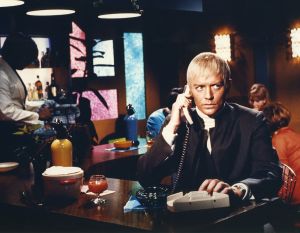 Straker no doubt making arrangements for JA's sabotage |
|||
Another Gerry Anderson reference: UFO was an early 1970's UK television sci-fi show[9], with UFO being archaically (and now comically) pronounced as "you-foe". According to Evangelion's character designer Yoshiyuki Sadamoto, the characters of Gendo and Fuyutsuki were modeled after UFO's Commander Ed Straker and Colonel Alec Freeman[1].
Straker was the commander of the clandestine Earth defence organisation SHADO, with Freeman as his right hand man. The two were often seen together.
Freeman's suit more obviously resembles Fuyutsuki's, but with buttons instead of a zip. But in fact Freeman at times wears a suit similar to Strikers straight zip suit.
Straker's SHADO zip up suit bears resemblence to Gendo's Nerv Uniform. Straker's uniform usually features a waistcoat, and lacks the themed cuffs of the Nerv uniforms.
The organisation SHADO which Straker commands is a clandestine with an underground HQ disguised beneath a film studio. Much of the show focuses on Straker's running of SHADO, as task which he is utterly devoted to, to the exclusion of his personal life.
Jason Hellwege writes:
"In Ep. ?? where they flash back through the setting up of NERV, there's a
scene where Fuyutsuki confronts Gendou in his office. Fuyutsuki has a briefcase on which he slides his nameplate across to reveal text on a red background reading "DESTRUCT NEGATIVE" on it. He then opens the case.
This is nearly identical to the exploding briefcase of Commander Straker from the Gerry Anderson series "UFO" (1969/70), the only difference being the location of the nameplate on the briefcase.
...I've also noticed that Anno was in his youth a member of an Anime society called "S.H.A.D.O.", SHADO being the military organisation from the series UFO. So it would appear that he should be familiar with the Anderson
universe(s)."
Childhood's End
Arthur C. Clarke's novel, Childhood's End, which was published in 1953 features a concept similar to Instrumentality. In Childhood's End, a race of devil-like aliens called the Overlords land on Earth and immediately put a stop to all wars, creating a virtual utopia on Earth. Years pass and children start displaying telephathic abilities. The Overlords reveal that their true purpose for arriving at Earth was to prepare humanity for absorbtion into the Overmind, an entity that exists as a hive-mind of consciousnesses from numerous civilizations. As the novel comes to a close, all adults have died off and the telephathic children, all that is left of humanity is absorbed into the Overmind.
The General Zapped an Angel
The cover of a 1970 edition of Howard Fast's SF anthology The General Zapped an Angel distinctly resembles the appearance of Lilith's head in the final scene of End of Evangelion. According to Wikipedia, 'Fast described the stories as "about the general childishness of man, the only form of life that refuses to grow up."'
Ultraman Ace
The next episode preview of Evangelion 3.0 at the end of the 2nd movie contained a scene with Fuyutsuki facing 4 shadowed figures with a circular pattern on the floor. The symbols actually come from Ultraman Ace, the 5th show in the Ultra series, which features the 5 Ultraman Brothers. Their crosses have the symbols found in the 3.0 preview. The flashback during Evangelion 2.0 of 2nd Impact which features the 4 "Adams" share similarities between the Ultramen as well.
References
- ↑ 1.0 1.1 Excerpt of "Interview with Sadamoto Yoshiyuki". Cite error: Invalid
<ref>tag; name "sadamoto" defined multiple times with different content - ↑ Youtube video of a famous dogfight scene by Anno and Ichiro "Itano Circus" Itano.
- ↑ Anno interview about Rahxephon
- ↑ http://sciencefictionbiology.blogspot.com/2007/09/farandolae.html
- ↑ http://www.imdb.com/title/tt0066769/
- ↑ http://harlanellison.com/home.htm
- ↑ http://en.wikipedia.org/wiki/Cordwainer_Smith
- ↑ http://www.cordwainer-smith.com/atomsk.htm
- ↑ Detailed UFO Series fansite.
